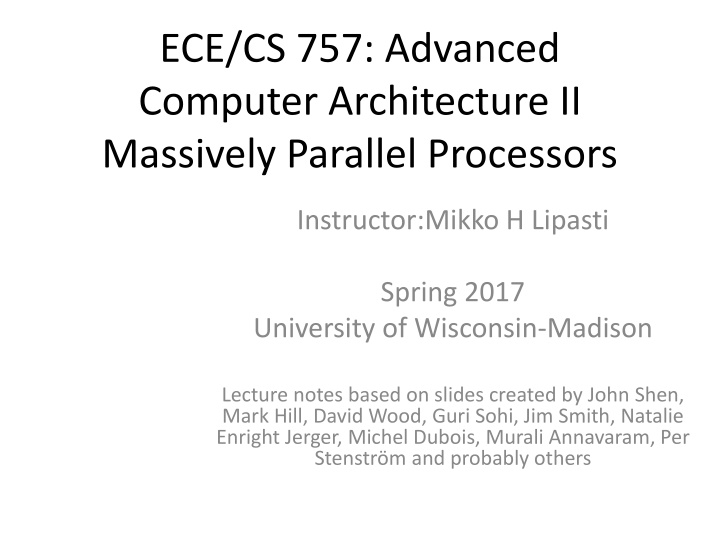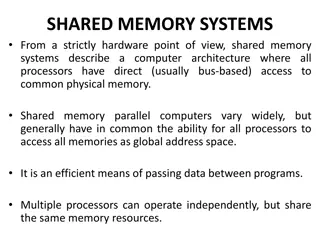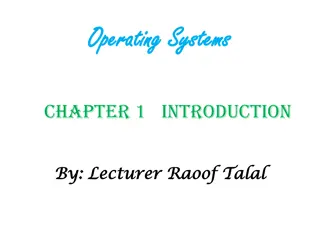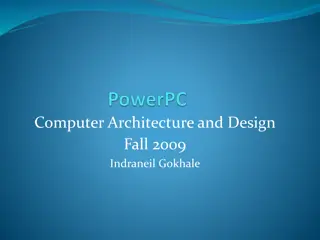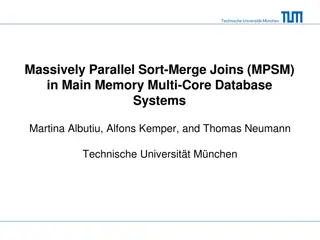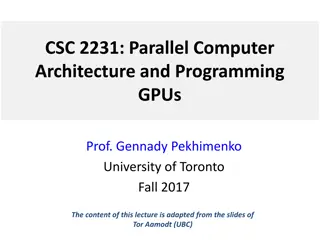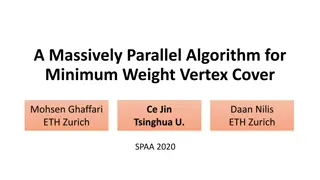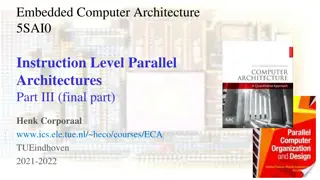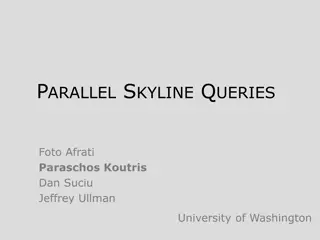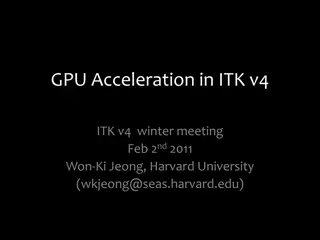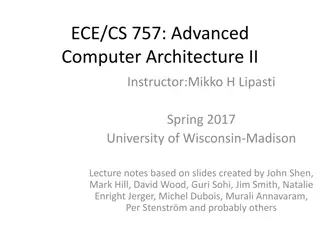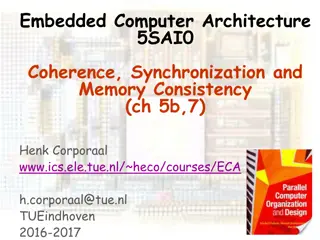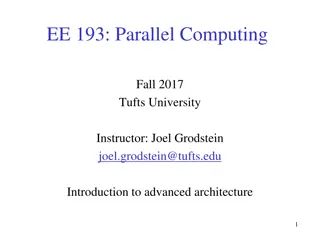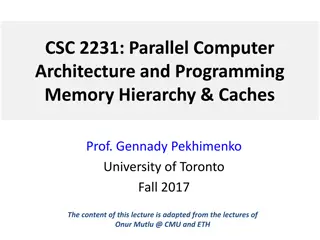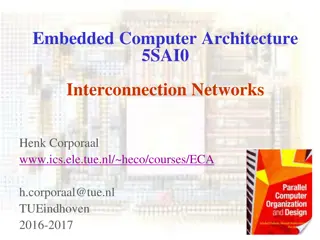Advanced Computer Architecture II: Massively Parallel Processors
The intricacies of massively parallel processors in advanced computer architecture. Dive into topics like software scaling, hardware scaling, case studies, scalability, and cost considerations. Understand the evolution of system architectures and the challenges of designing scalable solutions for parallel application programs. Delve into the nuances of algorithms and hardware behavior as systems grow in size and complexity. Gain insights into the evolving landscape of high-performance computing and the critical role of scalable architectures.
Uploaded on Mar 15, 2025 | 1 Views
Download Presentation

Please find below an Image/Link to download the presentation.
The content on the website is provided AS IS for your information and personal use only. It may not be sold, licensed, or shared on other websites without obtaining consent from the author.If you encounter any issues during the download, it is possible that the publisher has removed the file from their server.
You are allowed to download the files provided on this website for personal or commercial use, subject to the condition that they are used lawfully. All files are the property of their respective owners.
The content on the website is provided AS IS for your information and personal use only. It may not be sold, licensed, or shared on other websites without obtaining consent from the author.
E N D
Presentation Transcript
ECE/CS 757: Advanced Computer Architecture II Massively Parallel Processors Instructor:Mikko H Lipasti Spring 2017 University of Wisconsin-Madison Lecture notes based on slides created by John Shen, Mark Hill, David Wood, Guri Sohi, Jim Smith, Natalie Enright Jerger, Michel Dubois, Murali Annavaram, Per Stenstr m and probably others
Lecture Outline Introduction Software Scaling Hardware Scaling Case studies Cray T3D & T3E (C) 2007 J. E. Smith ECE/CS 757 2
MPP Definition etc. A (large) bunch of computers connected with a (very) high performance network Primarily execute highly parallel application programs Applications Typically number crunching Also used for computation-intensive commercial apps e.g. data mining May use distributed memory Computers or small SMP as nodes of large distributed memory system OR shared memory Processors connected to large shared memory Less common today Also hybrids Shared real space, assists for load/stores Scalable Interconnection Network Private Memory Private Memory Private Memory Proc. 0 Proc. 1 Proc. N-1 Shared Memory Memory 0 Memory 1 Memory M-1 Scalable Interconnection Network Processor 0 Processor 1 Processor N-1 (C) 2007 J. E. Smith ECE/CS 757
Scalability Term comes up often in MPP systems Over time: Computer system components become smaller and cheaper more processors, more memory Range of system sizes within a product family Problem sizes become larger simulate the entire airplane rather than the wing Required accuracy becomes greater forecast the weather a week in advance rather than 3 days Should designers come up with new system architectures for each generation? Or design a scalable architecture that can survive for many generations And be useful for a range of systems within a product family (C) 2007 J. E. Smith ECE/CS 757
Scaling How do algorithms and hardware behave as systems, size, accuracies become greater? Intuitively: Performance should scale linearly with cost But, easier said than done Software Scaling Algorithms, problem size, computational complexity, error analysis Hardware Scaling Lower level performance features scaling together (C) 2007 J. E. Smith ECE/CS 757
Cost Cost is a function of more than just the processor. Memory Interconnect I/O Cost is a complex function of many hardware components and software Cost is often not a "smooth" function Often a function of packaging how many pins on a processor chip how many processors on a board how many boards in a chassis (C) 2007 J. E. Smith ECE/CS 757
Performance How does performance vary with added processors? Depends on inherently serial portion vs. parallel portion Depends on problem size Depends on architecture and algorithm Depends on computation vs. communication (C) 2007 J. E. Smith ECE/CS 757
Speedup Review Let Speedup = Tserial / Tparallel Amdahl's law f = fraction of serial work; (1-f) = parallel fraction Speedup with N processors, S(N) = 1 / (f + (1-f)/N)) Maximum speedup = 1/f Eg. 10% serial work => maximum speedup is 10. (C) 2007 J. E. Smith ECE/CS 757
Effect of Problem Size Amdahl's law assumes constant problem size Or, serial portion grows linearly with parallel portion Often, serial portion does not grow linearly with parallel portions And, parallel processors solve larger problems. Example: NxN Matrix multiplication Initialize matrices, serial, complexity N Multiply matrices, parallel, complexity N3 (C) 2007 J. E. Smith ECE/CS 757
Problem Constrained Scaling User wants to solve same problem, only faster E.g., Video compression Amdahl s law is a limitation In many cases, problem sizes grow Reevaluating Amdahl's Law, John L. Gustafson, Communications of the ACM 31(5), 1988. pp. 532-533. (C) 2007 J. E. Smith ECE/CS 757
Example: Barnes-Hut Galaxy Simulation Simulates gravitational interactions of N- bodies in space N2 complexity Partition space into regions with roughly equal numbers of bodies Model region as a single point w/ gravity at center Becomes NlogN complexity (C) 2007 J. E. Smith ECE/CS 757
Galaxy Simulation w/ Constant Problem Scaling (C) 2007 J. E. Smith ECE/CS 757
Memory Constrained Scaling Let problem size scale linearly with number of processors. (assumes memory scales linearly with no. of processors) Scaled Speedup: rate(p)/rate(1) SpeedupMC(p) = work(p)/time(p)*time(1)/work(1) Even with good speedups, can lead to large increases in execution time if work grows faster than linearly in memory usage (C) 2007 J. E. Smith ECE/CS 757
Memory Constrained Scaling Matrix multiply example: f = N / (N + N3), and N grows so that N3 term dominates S(1) = 1 S(10) ~ 10 S(100) ~ 100 S(1000) ~ 1000 BUT, 1000 times increase in problem size 1,000,000 times increase in execution time, even with 1000 processors. (C) 2007 J. E. Smith ECE/CS 757
Time Constrained Scaling Execution time is kept fixed as system scales User has fixed time to use machine or wait for result Often realistic, e.g. best weather forecast overnight Render next frame in real time at 60fps Performance = Work/Time and time is constant, so: SpeedupTC(p) = work(p)/work(1) (C) 2007 J. E. Smith ECE/CS 757
Time Constrained Scheduling Overheads can become a problem: For matrix multiply, data set size can be increased by N 1/3 for 1000 x more processors, data size increases by 10. Problem grows slower than processors, Eventually performance gain will flatten And diminish due to overheads associated with smaller amounts of data per processor. Start with 100 element array 100 elements per 1 processor Scale up to 1000 processors 1 element per processor (C) 2007 J. E. Smith ECE/CS 757
Scaling Methodology Often problem sizes are increased to reduce error E.g. finer grids or time steps Must understand application to scale meaningfully (would user scale grid, time step, error bound, or some combination?) Equal Error Scaling Scale problem so that all sources of error have equal contribution to total error (C) 2007 J. E. Smith ECE/CS 757
Example: Barnes-Hut Galaxy Simulation Different parameters govern different sources of error at different rates Number of bodies (n) Time-step resolution (dt) Force calculation accuracy (fa) Scaling Rule All components of simulation error should scale at the same rate Na ve memory constrained scaling Scaling up problem size (and number of processors) Increases total execution time slightly (due to nlogn nature of problem) Equal error scaling Scaling up by a factor of k adds an additional factor of k3/4 kn reduces error by sqrt(k) Error is ~dt^2 so to get equal error scaling of sqrt(k) must decrease dt by by factor of k^0.25 (4th root) Error is ~(fa)^2 so to get equal error scaling of sqrt(k) must decrease (fa) by factor of k^0.25 These in combination cause k^3/4 increase (C) 2007 J. E. Smith ECE/CS 757
Hardware Scaling Bandwidth Scaling should increase proportional to # procs. crossbars multi-stage nets Latency Scaling ideally remain constant in practice, logn scaling can be achieved local memories help (local latency may be more important than global) latency may be dominated by overheads, anyway Cost Scaling low overhead cost (most cost incremental) in contrast to many large SMPs Physical Scaling loose vs. dense packing, 2D vs. 3D chip level integration vs. commodity parts (C) 2007 J. E. Smith ECE/CS 757
Case Study: Cray T3D Processing element nodes 3D Torus interconnect Wormhole routing PE numbering Local memory Support circuitry Prefetch Messaging Barrier synch Fetch and inc. Block transfers (C) 2007 J. E. Smith ECE/CS 757
Processing Element Nodes Two Alpha 21064 processors per node Shared block transfer engine (BLT) DMA-like transfer of large blocks of data Shared network interface/router Synchronous 6.67 ns clock (C) 2007 J. E. Smith ECE/CS 757
Communication Links Signals: Data: 16 bits Channel control: 4 bits request/response, virt. channel buffer Channel acknowledge: 4 bits virt. channel buffer status (C) 2007 J. E. Smith ECE/CS 757
Routing 3D Torus Dimension order routing may go in either + or - direction along a dimension Virtual channels Four virtual channel buffers per physical channel two request channels, two response channels Deadlock avoidance In each dimension specify a "dateline" link Packets that do not cross dateline use virtual channel 0 Packets that cross dateline use virtual channel 1 (C) 2007 J. E. Smith ECE/CS 757
Network Routers Separate X,Y,Z dimensions (C) 2007 J. E. Smith ECE/CS 757
Processing Nodes Processor: Alpha 21064 Support circuitry: Address interpretation reads and writes (local/non-local) data prefetch messaging barrier synch. fetch and incr. status (C) 2007 J. E. Smith ECE/CS 757
Processing Element Numbering Physical Includes all PEs in system Logical Ignores spare PEs; allows spares for failed nodes These are available to software Virtual What the application software sees OS does virtual to logical mapping (C) 2007 J. E. Smith ECE/CS 757
Address Interpretation T3D needs: 64 MB memory per node => 26 bits up to 2048 nodes => 11 bits Alpha 21064 provides: 43-bit virtual address 32-bit physical address (+2 bits for mem mapped devices) Annex registers in DTB external to Alpha 32-annex registers map 32-bit address onto 48 bit node + 27-bit address annex registers also contain function info e.g. cache / non-cache accesses DTB modified via load/locked store cond. insts. (C) 2007 J. E. Smith ECE/CS 757
Data Prefetch Architected Prefetch Queue 1 word wide by 16 deep Prefetch instruction: Alpha prefetch hint => T3D prefetch Performance Allows multiple outstanding read requests (normal 21064 reads are blocking) (C) 2007 J. E. Smith ECE/CS 757
Messaging Message queues 256 KBytes reserved space in local memory => 4080 message packets + 16 overflow locations Sending processor: Uses Alpha PAL code builds message packets of 4 words plus address of receiving node Receiving node stores message interrupts processor processor sends an ack processor may execute routine at address provided by message (active messages) if message queue full; NACK is sent also, error messages may be generated by support circuitry (C) 2007 J. E. Smith ECE/CS 757
Barrier Synchronization For Barrier or Eureka Hardware implementation hierarchical tree bypasses in tree to limit its scope masks for barrier bits to further limit scope interrupting or non-interrupting (C) 2007 J. E. Smith ECE/CS 757
Fetch and Increment Special hardware registers 2 per node user accessible used for auto-scheduling tasks (often loop iterations) (C) 2007 J. E. Smith ECE/CS 757
Block Transfer Special block transfer engine does DMA transfers can gather/scatter among processing elements up to 64K packets 1 or 4 words per packet Types of transfers constant stride read/write gather/scatter Requires System Call for memory protection => big overhead (C) 2007 J. E. Smith ECE/CS 757
Cray T3E T3D Post Mortem T3E Overview Global Communication Synchronization Message passing Kernel performance (C) 2007 J. E. Smith ECE/CS 757
T3D Post Mortem Very high performance interconnect 3D torus worthwhile Barrier network "overengineered" Barrier synch not a significant fraction of runtime Prefetch queue useful; should be more of them Block Transfer engine not very useful high overhead to setup yet another way to access memory DTB Annex difficult to use in general one entry might have sufficed every processor must have same mapping for physical page (C) 2007 J. E. Smith ECE/CS 757
T3E Overview Alpha 21164 processors Up to 2 GB per node Caches 8K L1 and 96K L2 on-chip supports 2 outstanding 64-byte line fills stream buffers to enhance cache only local memory is cached => hardware cache coherence straightforward 512 (user) + 128 (system) E-registers for communication/synchronization One router chip per processor (C) 2007 J. E. Smith ECE/CS 757
T3E Overview, contd. Clock: system (i.e. shell) logic at 75 MHz proc at some multiple (initially 300 MHz) 3D Torus Interconnect bidirectional links adaptive multiple path routing links run at 300 MHz (C) 2007 J. E. Smith ECE/CS 757
Global Communication: E-registers General Issue: Cache line-based microprocessor interface inadequate For strided accesses For multiple outstanding accesses Also, limited physical address space Extend address space Implement "centrifuging" function Memory-mapped (in IO space) Operations: load/stores between E-registers and processor registers Global E-register operations transfer data to/from global memory messaging synchronization (C) 2007 J. E. Smith ECE/CS 757
Global Address Translation E-reg block holds base and mask; previously stored there as part of setup Remote memory access (mem mapped store): data bits: E-reg pointer(8) + address index(50) address bits: Command + src/dstn E-reg (C) 2007 J. E. Smith ECE/CS 757
Global Address Translation (C) 2007 J. E. Smith ECE/CS 757
Address Translation, contd. Translation steps Address index centrifuged with mask => virt address + virt PE Offset added to base => vseg + seg offset vseg translated => gseg + base PE base PE + virtual PE => logical PE logical PE through lookup table => physical routing tag GVA: gseg(6) + offset (32) goes out over network to physical PE at remote node, global translation => physical address (C) 2007 J. E. Smith ECE/CS 757
Global Communication: Gets and Puts Get: global read word (32 or 64-bits) vector (8 words, with stride) stride in access E-reg block Put: global store Full/Empty synchronization on E-regs Gets/Puts may be pipelined up to 480 MB/sec transfer rate between nodes (C) 2007 J. E. Smith ECE/CS 757
Synchronization Atomic ops between E-regs and memory Fetch & Inc Fetch & Add Compare & Swap Masked Swap Barrier/Eureka Synchronization 32 BSUs per processor accessible as memory-mapped registers protected via address translation BSUs have states and operations State transition diagrams Barrier/Eureka trees are embedded in 3D torus use highest priority virtual channels (C) 2007 J. E. Smith ECE/CS 757
Message Passing Message queues arbitrary number created in user or system mode mapped into memory space up to 128 MBytes Message Queue Control Word in memory tail pointer limit value threshold triggers interrupt signal bit set when interrupt is triggered Message Send from block of 8 E-regs Send command, similar to put Queue head management done in software swap can manage queue in two segments (C) 2007 J. E. Smith ECE/CS 757
T3E Summary Messaging is done well... within constraints of COTS processor Relies more on high communication and memory bandwidth than caching => lower perf on dynamic irregular codes => higher perf on memory-intensive codes with large communication Centrifuge: probably unique Barrier synch uses dedicated hardware but NOT dedicated network (C) 2007 J. E. Smith ECE/CS 757
Recent Trends High-end microprocessors now include vector FP & high-BW DRAM Intel, AMD: SSEx/AVX DDRx evolution, on-chip MCs High-performance coherent caches: HT, QPI Higher-throughput FP also available through PCIe GPGPUs Nvidia s CUDA, AMD OpenCL Commodity NICs also provide high BW, low latency 10Gbit/25Gbit/40Gbit ethernet, RDMA support High-radix routers enable low-diameter datacenter topologies Clusters built out of: 2 socket SMP nodes, 16c/32t or more + GPGPU
Lecture Summary Introduction Software Scaling Hardware Scaling Case studies Cray T3D/Cray T3E (C) 2007 J. E. Smith ECE/CS 757 46
